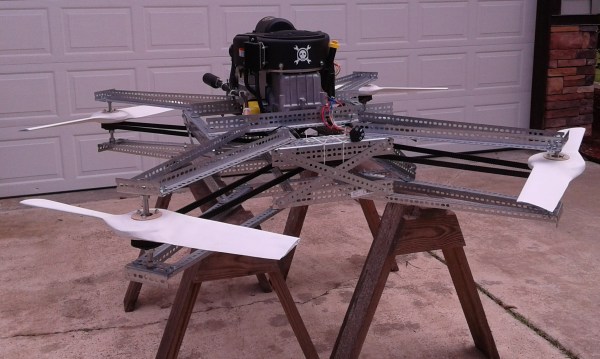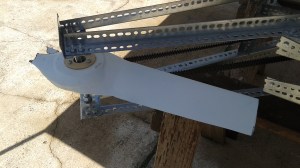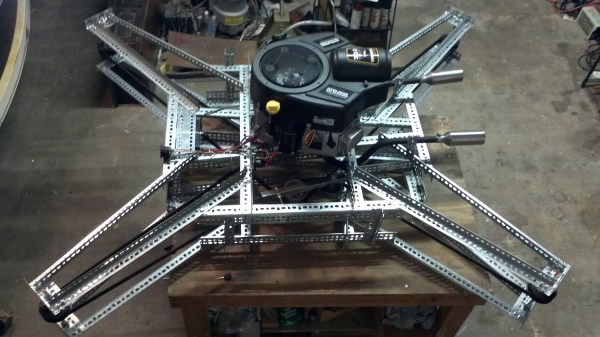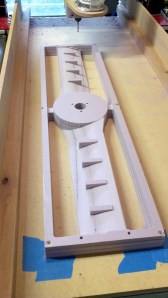Wait a minute. We’re almost through June and we haven’t seen anyone’s ‘DIY air conditioning’ setup. Oh the shame! How could we ever argue about thermodynamics otherwise? Here’s some copper tubing wrapped around a fan. Does it make sense? Assuming you’re making the ice (or cold whatever) in a room separated from the crappy air con, and you don’t have to pay for electricity (or ice), and you don’t mind hauling buckets of ice every few hours, yes. It’ll work. Now we can argue if you should put salt in the ice water…
I know I mentioned this in last week’s links post, but [Arsenijs]’s Raspberry Pi project is growing by leaps and bounds. He already has more than 33 followers to this project (awesome!) and 3.3k views on his project page. Not only is it climbing in popularity, but this is also a great use for the Raspberry Pi. You don’t see projects like this come around very often.
The Goliath is a quadcopter powered by a lawnmower engine. It was an entry in the first Hackaday Prize, but the project literally never got off the ground. There’s now a Mk. II version in the works. Goliath is getting a new frame made out of aluminum tube and rivets. There’s going to be ducts on the props, and this version might actually fly.
You did know Hackaday has it’s own Hackaspace, right? Technically it’s the Supplyframe Design Lab, but there are still a few skull ‘n wrenches hidden in the rafters. The Design Lab is hosting an open house this week on June 23rd, and the design lab residencies will begin July 1st. If you have an idea for something you’d like to build, here’s the residency application.
The LimeSDR is a powerful next generation software defined radio that’s currently on CrowdSupply The crowdfunding campaign ends in just a few days. It’s a very impressive tool, able to send and receive anything from 100 kHz to 3.8 GHz.
Last week one of our writers posted a review on the Monoprice MP Select Mini 3D printer. This printer is becoming stupidly popular, and Monoprice has depleted their inventory twice since then. I’ve been watching the product page for this printer for a while now, and here’s what happens: 1) Printer is out of stock, with an ETA of about a month in the future. 2) Printer is still out of stock, ETA is a few days away. 3) Monoprice has this printer in stock. This cycle seems to repeat every week or so.
Arduino Raycasting. When you think of raycasting, you probably think about Wolfenstein 3D, or other barely 3D games. You don’t need a powerful CPU like a 386 for raycasting – you can do it on an Arduino. The display is a 32×16 matrix of LEDs, control is through a Wii Nunchuck, and yes, head-bobbing is implemented. Here’s a video.







 While the tight new engine was quickly losing RPM, the propeller and belt system still had quite a bit of inertia. As the video after the break shows, the belts started flapping and caught on the propeller blades. The front right prop tip caught the double-sided toothed belt, pulling it up and over the propeller. The other end of that same belt lives on the right rear prop. It too caught a propeller blade, snapping the composite blade clean off its hub. The bent steel pulley axles are a testament to the forces at work when things went wrong.
While the tight new engine was quickly losing RPM, the propeller and belt system still had quite a bit of inertia. As the video after the break shows, the belts started flapping and caught on the propeller blades. The front right prop tip caught the double-sided toothed belt, pulling it up and over the propeller. The other end of that same belt lives on the right rear prop. It too caught a propeller blade, snapping the composite blade clean off its hub. The bent steel pulley axles are a testament to the forces at work when things went wrong.
 The propellers are works of art in their own right. [Peter] modeled the propellers in CAD using the principles of
The propellers are works of art in their own right. [Peter] modeled the propellers in CAD using the principles of 







